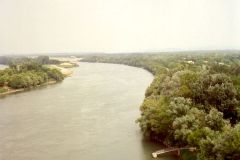We will explore Roman ruins and medieval fortresses in Provence. The name stems from its status as “province” in the Roman era.
Pont du Gard
There are many sites throughout Provence dating back to that period. The most famous are the theatre in Orange and the monuments in Arles, neither of which we visited, despite both being UNESCO World Heritage Sites.
On the other hand we went to Pont du Gard, also on that List. The magnificent old aqueduct has fascinated me for years. It doubles as a bridge across the Gardon river and is huge. This aqueduct was part of a 50 km long water-way running mostly beneath the ground. Think of it: The large amounts of running water only dropped 17 metres in height over the entire distance. Here it traversed the hillsides at a height of 48.8 metres above the river, making it the highest of all Roman aqueduct bridges.
The Pont du Gard dates back to the first century AD, and is remarkably well preserved. When I visited the bridge in 1991 we were allowed to walk across on top of it and even partly inside the water conduit. Not any more, I’m afraid. This time we crossed the bridge on the lowest of the three levels of arches.
Glanum
Glanum is an excavated Roman town from the 4th century AD just outside Saint-Rémy-de-Provence. There’s a triumphal arch and a very well preserved mausoleum on the site. The largest part of the area consists of the ruins of the town itself. This was boring for the children and I must admit that all the ruins troubled my patience as well. It was alright having been there. If you have an avid interest in Roman ruins you should be able to spend more than the hour I did.
Vaison-la-Romaine
We visited Vaison-la-Romaine for the market but made sure not to miss the Roman ruins. The River Ouvèze cuts right through the pleasant town, and is at one point bridged by a Roman construction, still in use after 2000 years. The Haute Ville (high town) has nice, narrow streets and a chateau on top. On the lower, older side we find two archaeological areas. The Puymin site includes a large Roman theatre, and at the quarter of La Villasse we found ruins of houses and baths.
Tarascon fortress (not Roman)
The Tarascon fortress has a perfect commanding location right on the River Rhône. If you’re looking for a typical European medieval fortress, here’s a great example. Although it was constructed quite late (1401) after the destruction of another, it has all the familiar features. It comes complete with a moat, high thick walls; it has a square shape and battlements on top. The Tarascon fortress is a heaven for boys of all ages. Inside there was a nice little garden with herbs and running water as well.
One of the most attractive architectonic features of Provence is “les villages perches“. We find these villages on hilltops as a result of the insecurity posed by the political turmoil of the Middle Ages. They offer a good view from behind the fortified walls, and have a network of narrow cobble stone streets, steps and arches. These days they are filled with artists, artisans, souvenir shops and visitors in large numbers.
Le Barroux
Le Barroux is a 12th century castle-fortress above the village bearing the same name. The fortress is a wonderful place to visit if you like this sort of thing. It looks, and is genuine. Moreover the village below is quite nice, small and not too drowned by other tourists.
Les Baux-de Provence
The old town of Les Baux-de Provence is a must on any itinerary to Provence. We visited it our last time in Provence and just had to return on this tour Roman ruins and medieval fortresses in Provence. It is one of the most popular villages perchés with a citadel dating back to the 900s on a windy summit. The citadel is now in ruins but offers a dramatic view of the surrounding landscape. The village is extremely picturesque.
Read more
The map shows places visited and roads travelled (approximately), including the mentioned ruins and fortresses in Provence.
This series has three articles.
(1) Provence – What is it? (more or less about the scenery)




















